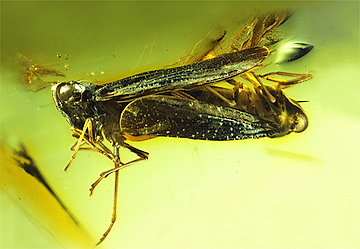Abstract
The green lacewings or Chrysopoidea are relatively rare in the fossil record, especially for the Cenozoic, while they seem to be rather diverse and frequent in the Mesozoic (Nel et al, 2005; Makarkin & Menon, 2005). The Chrysopidae seem to be better represented in the Eocene and the Miocene than in the Oligocene outcrops (e.g. Makarkin, 1991; Makarkin & Archibald, 2013). The Oligocene record for these insects is currently reduced to two species, both in the genus Nothochrysa McLachlan, 1868. Here we describe a new Oligocene green lacewing from the lacustrine Konservat-Lagerstätte of Aix-en-Provence.
References
Adams, Ph.A. (1967) A review of the Mesochrysinae and Nothochrysinae (Neuroptera: Chrysopidae). Bulletin of the Museum of Comparative Zoology, 135, 215–238.
Archibald, S.B., Makarkin, V.N., Greenwood, D.R. & Gunnell, G.F. (2014) The Red Queen and court jester in green lacewing evolution: bat predation and global climate change. Palaios, 29, 185–191.
https://doi.org/10.2110/palo.2013.089
Brooks, S.J. & Barnard, P.C. (1990) The green lacewings of the World: a generic review (Neuroptera: Chrysopidae). Bulletin of the British Museum, (Natural History), Entomology, 59, 117–286.
Gaudant, J., Nel, A., Nury, D., Véran, M. & Carnevale, G. (2018) The uppermost Oligocene of Aix-en-Provence (Bouches-du-Rhône, Southern France): a Cenozoic brackish subtropical Konservat-Lagerstätte, with fishes, insects and plant. Compte Rendus Palevol, 17, 460–478.
https://doi.org/10.1016/j.crpv.2017.08.002
Jiang, Y.L., Garzón-Orduña, I.J., Winterton, S.L., Yang, F. & Liu, X.Y. (2017) Phylogenetic relationships among tribes of the green lacewing subfamily Chrysopinae recovered based on mitochondrial phylogenomics. Scientific Reports, 7 (7218), 1–9.
https://doi.org/10.1038/s41598-017-07431-1
Makarkin, V.N. (1991) Miocene Neuroptera from Northern Caucasus and Sikhote-Alin. Paleontological Journal, 25, 55–65.
Makarkin, V.N. & Archibald, S.B. (2013) A diverse new assemblage of green lacewings (Insecta, Neuroptera, Chrysopidae) from the Early Eocene Okanagan Highlands, Western North America. Journal of Paleontology, 87, 123–146.
https://doi.org/10.1666/12-052R.1
Makarkin, V.N. & Menon, F. (2005) New species of the Mesochrysopidae (Insecta, Neuroptera) from the Crato Formation of Brazil (Lower Cretaceous), with taxonomic treatment of the family. Cretaceous Research, 26, 801–812.
https://doi.org/10.1016/j.cretres.2005.05.009
Makarkin, V.N., Wedmann, S. & Weiterschan, T. (2018) First green lacewings from the late Eocene Baltic amber. Acta Palaeontologica Polonica, 63, 527–537.
https://doi.org/10.4202/app.00504.2018
Nel, A. (1991) Analyse d’Entomofaunes cénozoïques. Intérêt de la Paléoentomologie pour les Sciences de la Terre et de la Vie. Thèse de Doctorat (nouveau régime), Université de Reims-Champagne-Ardenne. Soutenue le 13. 12. 1991, 1–882.
Nel, A. & Séméria, Y. (1986) Une nouvelle espèce de Chrysopidae fossile du Stampien supérieur (Oligocène) d’Aix-en-Provence Notochrysa stampieni n. sp. (Neuroptera, Chrysopidae, Notochrysinae). Neuroptera International, 4, 23–30.
Nel, A., Martinez-Delclòs, X. & Hutin, A. (2005) Mesozoic chrysopid-like Planipennia: a phylogenetic approach (Insecta, Neuroptera). Annales de la Société Entomologique de France, (N.S.), 41, 29–68.
https://doi.org/10.1080/00379271.2005.10697440
Peñalver, E., Nel, A. & Martínez-Delclòs, X. (1995) New Nothochrysinae from the Spanish Miocene (Neuroptera: Chrysopidae). Bulletin de la Société Entomologique de France, 100, 481–487.
Song, N., Li, X.X., Zhai, Q., Bozdogan, H. & Yin, X.M. (2019) The mitochondrial genomes of neuropteridan insects and implications for the phylogeny of Neuroptera. Genes, 10 (108), 1–19.
https://doi.org/10.3390/genes10020108
Statz, G. (1936) Über neue Funde von Neuropteren, Panorpaten und Trichopteren aus den tertiären Schiefern von Rott am Siebengebirge. Decheniana, Verhandlungen des Naturhistorischen Vereins der Rheinlande und Westfalens, (A), 93, 208–255.

